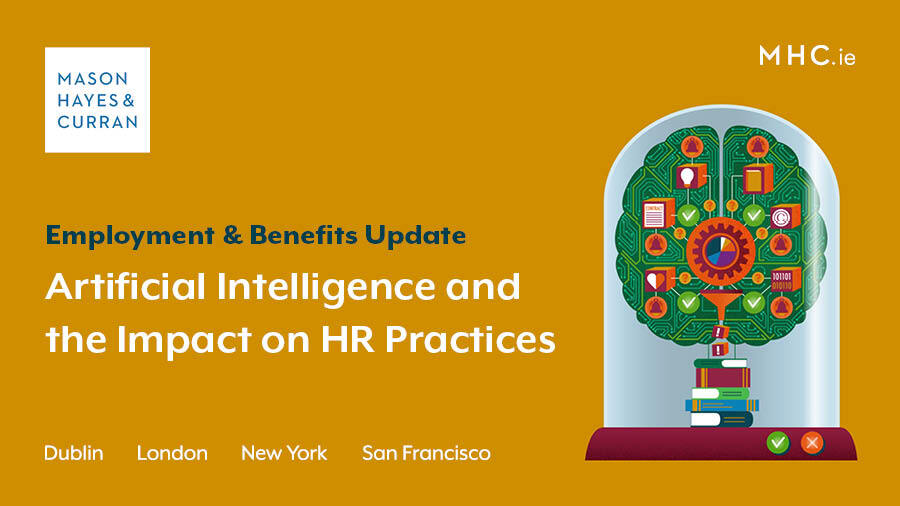Artificial Intelligence and the Impact on HR Practices

The recent proliferation of artificial intelligence technologies continues to have a profound impact on the operations of companies in all industries and sectors. Human resources management is an area which can benefit greatly from the efficiencies gained through its adoption. However, certain issues can arise which employers need to be cognisant of. Our Employment & Benefits team examines the use of AI solutions in three main areas of HR, namely: recruitment, performance management and employee monitoring.
Artificial Intelligence (AI) systems are increasingly being adopted by HR practitioners. Its benefits can include increased productivity, efficiency and cost reductions. However, while case law is yet to be developed, there is potential for a broad range of claims from employees or job applicants where AI has made or influenced an unfair, biased or discriminatory decision affecting their employment.
In this article, we look at those HR practices which may lend themselves to AI deployment, namely recruitment, performance management and employee monitoring together with some of the potential risks that its deployment might pose to employers.
Recruitment
AI-powered software simplifies the recruitment process by scheduling interviews, screening applications and matching suitable candidates to jobs. The danger of AI, however, is its potential for bias and discrimination in a recruitment context. AI systems are trained using existing data, that can inadvertently cause pre-existing biases to be pronounced, particularly in instances where a workplace already lacks diversity. The capacity of AI to discriminate was highlighted in 2014 when Amazon had to cease using an AI recruitment tool that favoured male applicants.
It has also been reported that candidates from ethnic minorities or with certain disabilities, such as speech impediments or neurological conditions, find it more difficult to engage with AI interview software which analyses speech patterns or facial expressions.
Performance management
AI is increasingly used by employers to review employees’ performance, particularly in roles where ‘real-time’ performance data is readily available.
Technology is constantly evolving, and some AI systems can now forecast an employee’s future performance by assessing historical data, or predictive analytics. While AI can provide valuable insight, it should not replace human judgement and employers should tread carefully when using AI to make a decision affecting an employee’s employment.
By way of example, in 2022, three make-up artists employed in the UK by an Estée Lauder subsidiary, MAC Cosmetics, were made redundant partly based on an assessment of their performance carried out during an AI video interview. The employees, who had no prior performance issues, were asked about make-up application, which the employees argued required a practical demonstration. The AI software assessed both the content of the employees’ answers and facial expressions. However, prior to the redundancy decision being made final, no human person reviewed the AI video. As this case was settled out of court, we are unable to deduce what decision a third party might make on the usage by AI in the management of performance or selection for redundancy.
Employee monitoring
Employee monitoring is not a new phenomenon. It is accepted that certain roles require CCTV, drugs testing, and the monitoring of e-mails. However, since the COVID-19 pandemic, studies available online suggest that approximately 85% of employers are concerned about workers’ productivity, and in particular remote workers.
As a result, some businesses have deployed AI monitoring software which can allow employers to view unsent e-mails, webcam footage, microphone input and keystrokes. This extreme level of monitoring can violate an employee’s right to privacy. Under GDPR, employee monitoring must be necessary, legitimate and proportionate. Employers must be fully transparent about:
- What AI they are using
- When they are using it
- Why they are using it, i.e. the legal basis, and
- The impact of its use on employees
Where an employer uses AI-generated data, for example performance data, to make decisions affecting an employee’s employment, the employer should act fairly and lawfully and verify that the data is accurate. Failure to comply with data protection legislation could lead to reputational damage and significant fines being imposed on employers.
In 2021, for example, a €2.6 million fine was imposed by the Italian data protection authority on Foodinho, an Italian app-based food delivery company, for breaches of GDPR related to its use of an algorithm to allocate work to delivery riders based on an AI-generated scoring of their reputations.
Tips for employers when deploying AI-based HR solutions
- Be transparent: Consider implementing an employment policy governing the use of AI. Ensure AI systems are compliant with existing workplace policies, in particular data protection policies and privacy notices.
- Assess Risk: Carry out a risk assessment and a data protection impact assessment for each AI system.
- Retain a human element: Ensure managers make final decisions regarding employees’ employment.
- Training: Deliver AI training to managers and HR staff and ensure it covers accuracy and bias.
The future of AI in the workplace
The use of AI is due to become regulated in the coming months as the EU’s new AI Act was endorsed by member states on 2 February 2024. Once the Act comes into effect, developers of AI technologies will be subject to stringent risk management, data governance, transparency and human oversight obligations.
It is worth noting in this regard that the Act classifies AI in the category “employment, work management and access to self-employment” as a high-risk AI system. Accordingly, this will need to be assessed before going on the market and throughout their lifecycle, though many systems are currently on the market and in use.
For more information and expert advice regarding the deployment of AI in the workplace, contact a member of our Employment Law & Benefits or Artificial Intelligence teams.

The content of this article is provided for information purposes only and does not constitute legal or other advice.
Share this:





